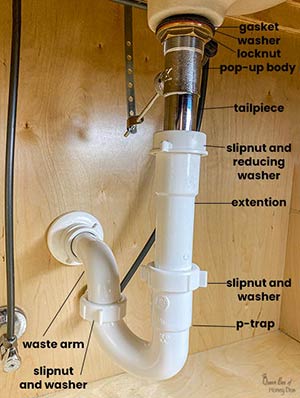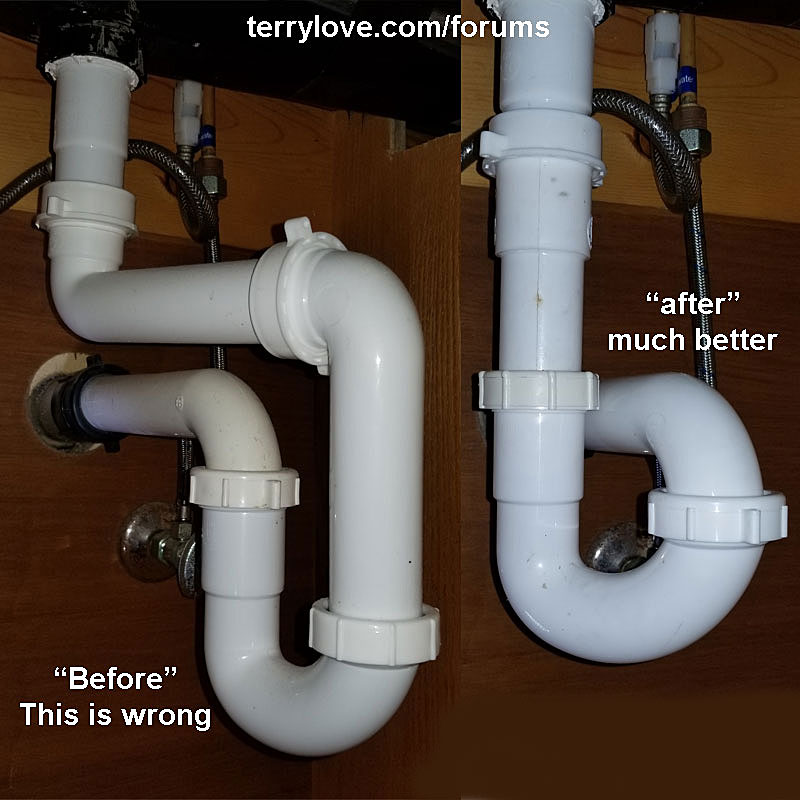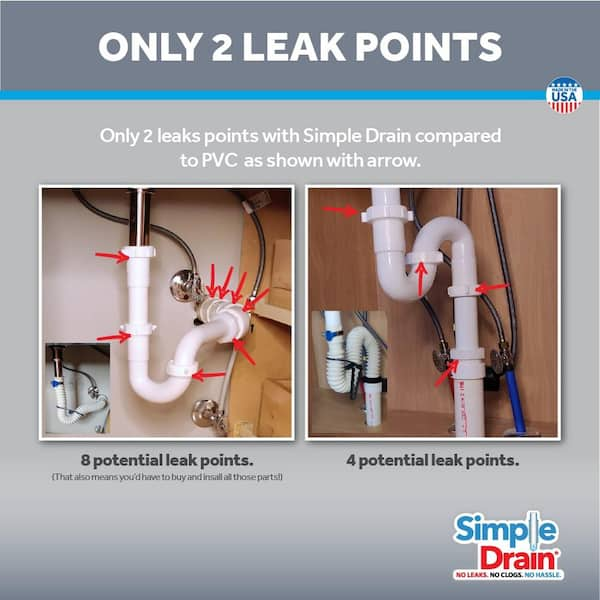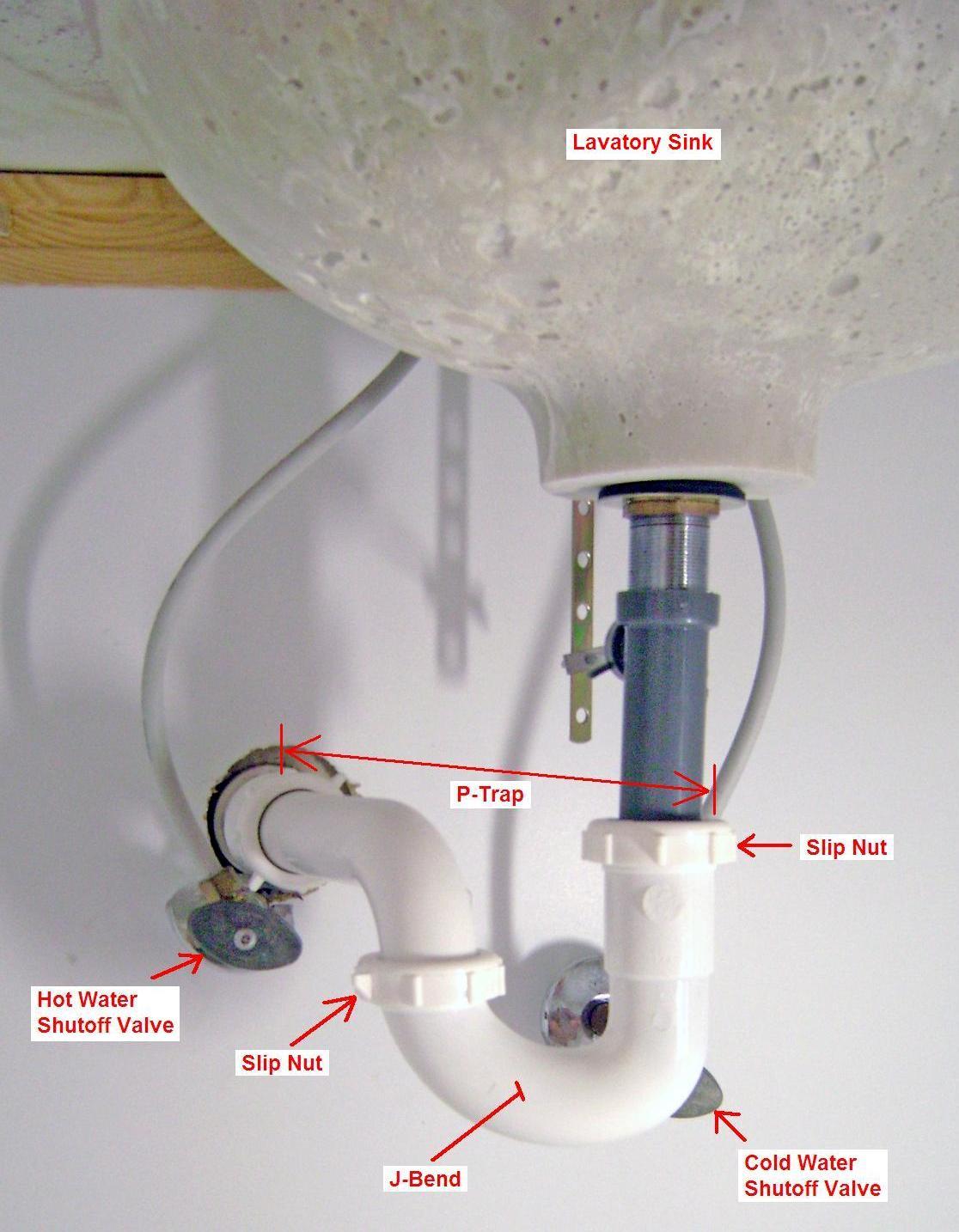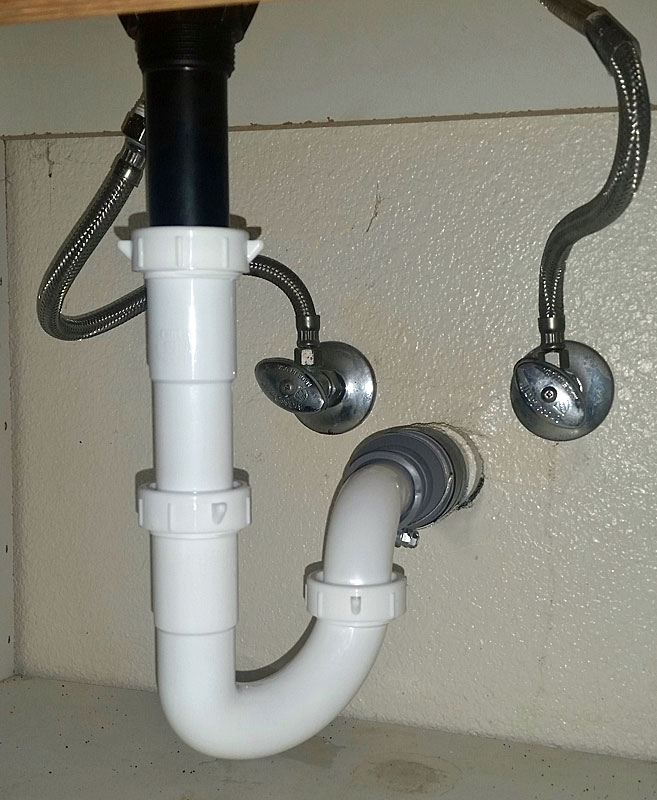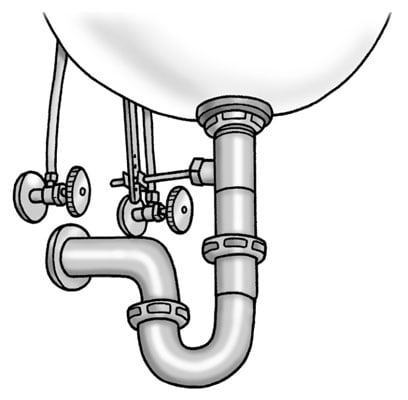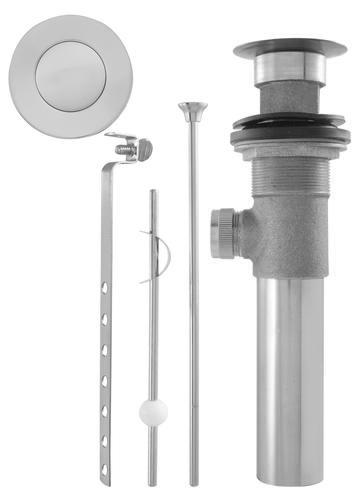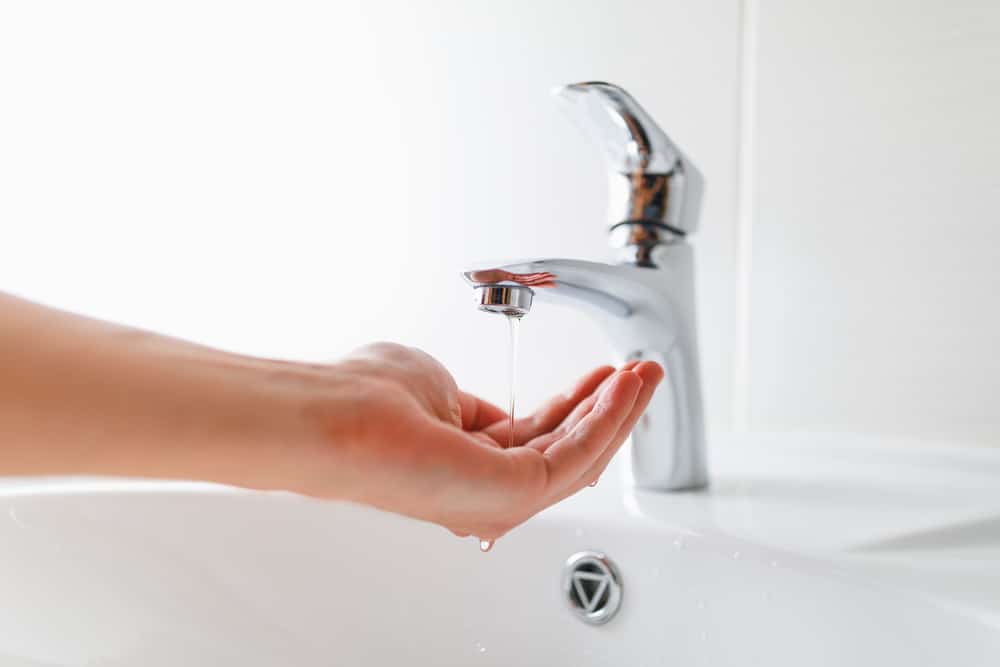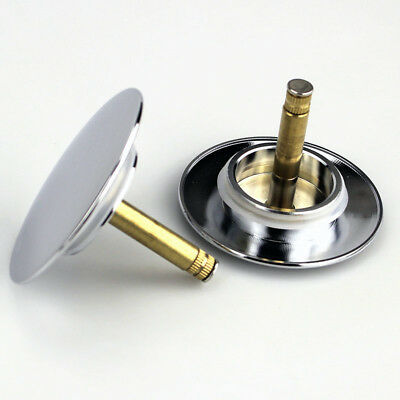Understanding the Role of the Bathroom Sink Drain Trap
The bathroom sink drain trap may appear insignificant, but it plays a crucial role in your plumbing system. Here’s why it’s essential:
- Creates a Seal: By holding water in its curved section, the drain trap forms a seal that prevents sewer gases from entering your home. This seal is vital for maintaining indoor air quality and preventing unpleasant odors.
- Prevents Clogs: The drain trap acts as a barrier against debris, hair, and other particles that could potentially clog your pipes. It traps these materials before they can cause blockages, helping to keep your sink and drainage system clear.
- Based on Gravity and Pressure: The design of the drain trap relies on the principles of gravity and hydrostatic pressure. The water in the trap creates a barrier that stops sewer gases from traveling back up through the drain and into your home.
- Various Shapes for Effectiveness: Drain traps come in different shapes, with the P-trap being the most common. Its distinctive shape allows for easy installation and maintenance while providing an effective barrier against sewer gases.
- Prevents Health Hazards: Without a functioning drain trap, your home would be susceptible to foul odors and potential health hazards associated with exposure to sewer gases. The drain trap serves as a protective barrier, ensuring a safe and healthy environment.
Common Types of Bathroom Sink Drain Traps and How They Work
Bathroom sink drain traps come in various shapes and configurations, each with its unique set of features and benefits. The most common types include P-traps, S-traps, and bottle traps, each named for their distinctive shapes when viewed from the side.
P-traps: Perhaps the most widely used type of drain trap, the P-trap resembles the letter “P” when viewed horizontally. It features a curved section of pipe that holds water, effectively creating a seal against sewer gases. P-traps are versatile and suitable for most sink installations.
S-traps: Less common in modern plumbing systems, S-traps form an “S” shape and were prevalent in older homes. They work similarly to P-traps but are more prone to siphoning water out of the trap, potentially allowing sewer gases to enter the home.
Bottle traps: Compact and space-saving, bottle traps consist of a cylindrical chamber that holds water, often enclosed within a decorative housing. While aesthetically pleasing, they may require more frequent cleaning due to their smaller size.
Maintenance Tips to Keep Your Bathroom Sink Drain Trap Clear
Maintaining a clear bathroom sink drain trap is essential for preventing clogs and ensuring proper drainage in your home. Fortunately, with a few simple maintenance tasks, you can keep your drain trap functioning smoothly and avoid costly repairs.
Regular cleaning: One of the most effective ways to prevent clogs in your bathroom sink drain trap is by regularly cleaning it. Remove the trap from beneath the sink and use a brush or pipe cleaner to scrub away any buildup of hair, soap scum, or debris.
Use a drain strainer: Installing a drain strainer or stopper in your sink can help prevent larger particles from entering the drain trap and causing clogs. Empty the strainer regularly to ensure proper water flow.
Flush with hot water: Periodically flushing your drain trap with hot water can help dissolve grease and soap residue that may be accumulating inside the pipes. Simply pour boiling water down the drain to help keep it clear and odor-free.
Avoid chemical cleaners: While it may be tempting to use chemical drain cleaners to clear clogs, these products can damage your pipes and harm the environment. Instead, opt for natural alternatives such as baking soda and vinegar or invest in a mechanical drain snake for stubborn blockages.
Signs of a Faulty Bathroom Sink Drain Trap
A faulty bathroom sink drain trap can lead to a range of plumbing problems, from slow drainage to foul odors and even water damage. Knowing the signs of a malfunctioning drain trap can help you address issues promptly and avoid more significant repairs down the line.
Slow drainage: If water is slow to drain from your sink despite your best efforts to clear clogs, it could indicate a problem with the drain trap. A buildup of debris or a partial blockage in the trap may be impeding the flow of water, requiring professional attention to resolve.
Foul odors: A strong, unpleasant smell emanating from your bathroom sink is a telltale sign of a malfunctioning drain trap. Sewer gases may be escaping through a broken seal or damaged pipe, indicating the need for immediate repairs to prevent further issues.
Visible leaks: If you notice water pooling beneath your sink or dripping from the pipes, it could indicate a leak in the drain trap or surrounding plumbing components. Ignoring these leaks can lead to water damage and mold growth, so it’s essential to address them promptly.
Rust or corrosion: Visible signs of rust or corrosion on the exterior of your drain trap may indicate underlying damage to the pipes. Left unchecked, this corrosion can weaken the trap and lead to more significant issues over time.
Eco-Friendly Options for Bathroom Sink Drain Traps
In an age of increasing environmental awareness, eco-friendly options for bathroom sink drain traps offer homeowners the opportunity to reduce their carbon footprint and conserve water without sacrificing performance.
Water-saving designs: Some modern drain traps are designed to minimize water usage by utilizing smaller volumes of water in the trap while still maintaining an effective seal against sewer gases. These water-saving designs can help reduce your household’s water consumption and lower utility bills over time.
Biodegradable materials: Opting for drain traps made from biodegradable materials such as recycled plastics or plant-based resins can help minimize your environmental impact. These materials break down more readily in landfill conditions, reducing the amount of waste that ends up in our oceans and landfills.
Low-flow fixtures: Installing low-flow fixtures such as aerators and flow restrictors on your bathroom sink can help reduce water usage and prevent unnecessary waste. These fixtures work by mixing air with the water stream, maintaining strong water pressure while using less water overall.
DIY alternatives: For the eco-conscious homeowner, DIY alternatives such as homemade drain cleaners using natural ingredients like baking soda and vinegar offer a sustainable solution for keeping your drain trap clear without resorting to harsh chemicals.
What is a bathroom sink drain trap?
A bathroom sink drain trap is a crucial component of your plumbing system located beneath the sink. It’s a curved section of pipe designed to hold water and create a seal that prevents sewer gases from entering your living space. This simple yet effective device acts as a barrier against debris, hair, and other particles, helping to prevent clogs and maintain proper drainage.
Why is the drain trap necessary?
The drain trap serves multiple purposes. Firstly, it prevents foul odors from emanating into your home by blocking sewer gases from backing up through the drain. Secondly, it traps debris and prevents it from entering the pipes, thus reducing the risk of clogs and blockages. Without a functioning drain trap, you could experience unpleasant odors, slow drainage, and potential plumbing issues.
What are the different types of drain traps?
The most common types of bathroom sink drain traps include P-traps, S-traps, and bottle traps. P-traps are shaped like the letter “P” and are versatile, easy to install, and effective at trapping debris. S-traps, although less common in modern plumbing, form an “S” shape and function similarly to P-traps but are more prone to siphoning water out of the trap. Bottle traps consist of a cylindrical chamber and are space-saving, although they may require more frequent cleaning due to their smaller size.
How does a drain trap work?
When water flows down the sink drain, it passes through the drain trap’s curved section, which holds a small amount of water at all times. This water creates a seal that blocks sewer gases from entering your home while still allowing wastewater to pass through. The design of the drain trap relies on the principles of gravity and hydrostatic pressure to maintain the seal and prevent gases from traveling back up through the drain.
How can I maintain my bathroom sink drain trap?
Regular maintenance is essential to keep your drain trap functioning properly. This includes periodically cleaning the trap to remove debris and hair buildup, using a drain strainer to prevent larger particles from entering the trap, and flushing the trap with hot water to dissolve grease and soap residue. Avoid using chemical drain cleaners, as they can damage the pipes and harm the environment. Instead, opt for natural alternatives like baking soda and vinegar or mechanical drain snakes for stubborn clogs.
What are the signs of a faulty drain trap?
Signs of a faulty bathroom sink drain trap include slow drainage, foul odors emanating from the sink, visible leaks or water damage beneath the sink, and rust or corrosion on the exterior of the trap. If you notice any of these signs, it’s essential to seek repairs from a qualified plumber to prevent further damage to your plumbing system.
SIMPLE DRAIN 1.25 in. Rubber Threaded P-Trap Bathroom Single Sink
Plumbing Codes and Stuff u2014 Lavatory plumbing
How To Install Bathroom Sink Drain Kit – KNOW IT INFO
Creating an S-trap to raise the height of a bathroom sink drain
Types of Plumbing Traps and How They Work – BestLife52
plumbing – Sink tailpiece doesnu0027t line up with trap – Home
Snappy Trap Universal Drain Kit for Bathroom Sinks
How to Install the P-Trap under a Sink – dummies
Related Posts:
- 2 Sink Bathroom Vanity Ideas
- Bathroom Sinks With Glass Countertop
- Japanese Bathroom Sink
- No Cold Water In Bathroom Sink
- Bathroom Sink Drain No Overflow
- Parts Of Bathroom Sink Plumbing
- Diy Under Bathroom Sink Organizer
- Replacing Bathroom Sink Faucet And Drain
- Do It Yourself Bathroom Sink
- How To Replace Bathroom Sink And Countertop
